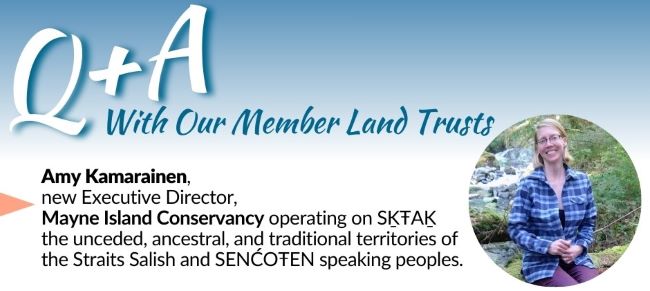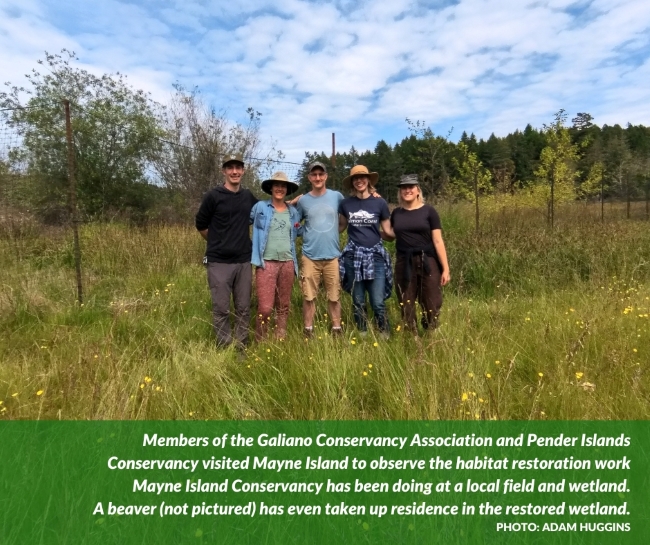Land Trust Q&A: Mayne Island Conservancy

Was there a particular moment or event in your life that drew you to conservation work?
I grew up in a rural part of Michigan called the Upper Peninsula. I spent a lot of time outdoors with my family, fishing, hunting, and farming on land near Lake Superior. I grew up engaged with and connected to my environment which helped me understand the hard work and learning that go into stewardship.
How has your life led you to your new role as Executive Director of Mayne Island Conservancy?
After completing my PhD in Zoology (with a focus on understanding how aquatic systems are affected by agriculture), I worked with a team of cognitive psychologists, educators, and technologists on research related to environmental education. We designed environmental education pieces that leveraged virtual and augmented reality, and we were looking at how those emerging technologies might be used to connect kids’ learning in the classroom to outdoor experiences like field trips.
Later I became the Executive Director of Salmon Coast, a small nonprofit organization based in Kwikwasut’inuxw Haxwa’mis territory near a remote part of northern Vancouver Island. In that work I was supporting both education and environmental research. I was helping to manage Salmon Coast’s remote field station and support the research and monitoring work in that region.
A few years ago, a work opportunity for my husband brought us to beautiful Mayne Island, where we have some land that we love and nurture.
When the Conservancy’s ED position came up, I knew it was something that strongly matched my goal for being involved in a community-based organization focused on conservation.
What stands out for you so far about this organisation?
I’ve always been impressed by the Conservancy, especially with the diversity of projects and programs underway: kelp monitoring, habitat restoration, bird walks, beach cleanups. The Conservancy runs amazing family and youth education programs, and I’ve been inspired by the speaker series and other events.
I think the Conservancy’s biggest strength is our team. I couldn’t imagine staff members who are better suited to support the work of the Conservancy, a team with deep knowledge of habitat restoration, invasive species removal, community engagement and education, and conservation stewardship agreements and covenants… the kinds of tools we need to meet our land and waters protection goals.
Another huge asset for the Conservancy is our incredible volunteers, including our board of directors. The directors are committed to fostering this work, and one of the ways that has played out is in doing our best to build deeper relationships and think about ways we can collaborate on conservation with the Indigenous Peoples who have stewarded this land since time immemorial, and who have ongoing relationships with SḴŦAḴ | Mayne Island.
What do you predict will be your biggest conservation challenge?
There will always be ongoing challenges, especially invasive plant and wildlife species. Controlling invasive species is critical to realizing our vision of preserving a healthy, rich Douglas fir ecosystem. We take on this challenge with the help of our amazing volunteers, the Mayne Island community, and partner organizations like the Deer Management Society which is focusing on ways we can address the Fallow deer problem.
Another challenge is our goal to protect 30% of the island by 2033. One of the things I’m excited about in relation to this vision is the idea of thinking globally but acting locally. With organisations worldwide committing to the global initiative to protect 30% of land and waters by 2030 in order to preserve biodiversity and help with habitat conservation, I think it’s amazing for Mayne Island to commit to this kind of work at our local island level.

What would you like to accomplish, and what are your hopes for the future of your organization?
Creating a “culture of conservation” is the best way to really accomplish our goal of protecting 30% of Mayne Island by 2033 – finding ways to work with people throughout the community and offering opportunities for people to deepen their connections with the lands and waters on the island, this would be a huge win. We are well on our way in terms of our diversity of programs and the ways for people to get involved, like family nature explorations, light trap monitoring, engaging in a covenant or a stewardship agreement on their land, or helping with invasive species removal.
I would also like to build on our relationships with regional partners, to connect and collaborate with conservancies on other Gulf Islands and across the region. This is a great time to learn from one another, and to have opportunities to work together in ways that support each other and realize a vision of conservation that reaches across the Gulf.


